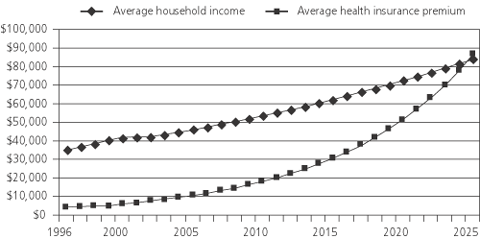
Am Fam Physician. 2005;72(10):1989
If current trends continue, U.S. health insurance costs will consume the average household’s annual income by 2025. As health care becomes unaffordable for most people in the United States, it will be necessary to implement innovative models to move the system in a more equitable and sustainable direction.
In 2004, premiums for employer-sponsored health insurance increased by 11.2 percent—the fourth consecutive year of double-digit increases—outpacing the 2004 national wage increase of 2.2 percent.1 Employers increasingly view health insurance as an unaffordable benefit. Already, only one half of employers with fewer than 10 employees offer health insurance. Larger employers are outsourcing jobs and shifting more of the health care costs onto their employees who, in some cases, cannot afford to purchase coverage for their families.2 If health insurance premiums and national wages continue to grow at current rates, the average cost of a family health insurance premium will surpass the average annual household income by 2025 (see accompanying figure),2,3 approximately the time when the Medicare trust fund is projected to be insolvent.4
With health insurance packages bought and sold as profitable commodities, adequate health insurance coverage will soon be a product of shrinking benefits, to be bought by the wealthy and sold to the healthy. Most individuals cannot shoulder the burden of rising health care costs, and medical expense now tops the list of reasons for personal bankruptcy.5,6 If the system remains the same, the number of uninsured will continue to grow.

Shifting health care coverage from a commodity to a social good could reduce disparities and produce better population health. Changes in health care coverage will require more equitable and sustainable models of health care delivery and aligned advocacy to support them. The instability of health care financing and delivery provides an opportunity for family physician leaders to develop new models of efficient practice, with care that is accessible to everyone.7